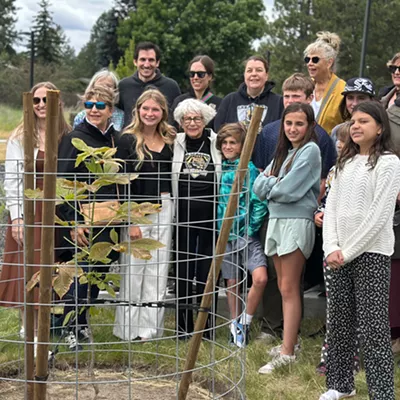Tofu Phil's journey toward a life of soy products started, as any soy journey would, in Southern California back in the late '70s. Trying to strengthen his vegetarian diet, he started researching homemade food.
"I bought this book called The Book of Tofu, by William Shurtleff and Akiko Aoyagi," says Tofu Phil. "It taught me how to make tofu at home, so I started doing that."
Tofu Phil says he never took his talent for tofu-making seriously until he moved to the Inland Northwest many years later.
"I quit my job, sold my home, bought property in Pend Oreille and looked into starting a tofu business," Tofu Phil says. He teamed up with others in the area to look into the possibilities.
"We thought, 'It'll never work,'" he says. "We said, 'These people won't buy tofu -- they don't even know what it is.'"
Instead of opening a tofu shop in a meat-and-potatoes town, Tofu Phil worked in Spokane for 11 years as an engineer.
"I got laid off, then re-hired, and then laid off again. I wasn't in control at all," Tofu Phil says. His thoughts turned back to soybeans.
In 1992, Tofu Phil started making tofu at night after his day job. He named his business Small Planet Tofu. Working out of a garage in Hillyard, he produced about 300 pounds every week.
"It soon went to 600 [pounds], which went to 1,200, [then] to 2,000. Now we're here," Tofu Phil says, referring to his bustling 'tofu factory' nestled just off Highway 2, outside Newport, Wash. "I have 12 employees. Four of them are full-time. We make 5,000 pounds of tofu a week and distribute all over the West Coast. I am now contracting another tofu maker in Kansas -- they make our flavors of tofu for distribution in the Midwest."
Small Planet Tofu is certified organic, handmade and handcrafted. The company gets its soybeans from a co-op of 46 organic farms in Kansas.
"Instead of dealing with brokers, which are middlemen, I'm working with the farmers, supporting them directly," Tofu Phil says. "We're making food from a renewable source. It's whole food for the whole person."
Steam fills the air at the Small Planet Tofu factory, as water-saturated soybeans are ground in 60-gallon steam jacketed kettles. A roller-extractor separates the pulp from the protein-filled liquid referred to as soymilk.
"The soy pulp byproduct is sent off to a woman with 110 emus," Tofu Phil explains, pointing to a massive bucket of yellow meal. "They eat it all in one day."
Magnesium chloride, the second most prominent mineral in seawater, is added to the soymilk mixture. Then the flavors are poured, in forming curdle and whey. The tofu is compacted, then chilled, cut, packaged, labeled and stored - all in within three rooms.
"It's not mass-produced," Tofu Phil says proudly. "Our flavors are unique; we call our tofu 'the microbrew of tofu,' because we're trying to educate people that not all tofu is the same. You can buy a Hyundai or you can buy a Lexus."
Small Planet Tofu manufactures a variety of flavored - and baked - tofu which sells for anywhere from $2.39-$3.39 a pound. It's sold in grocery stores throughout the Northwest. Small Planet also provides tofu to some of the best restaurants in the region, including Luna, Mizuna, Fugazzi, Down River Grill, the Elk, Moontime and the Porch, the Mustard Seed, Laskars, the Davenport Hotel and Takara.
"We sell it to a lot of fire crews, some colleges, and we give a lot to the Heart Institute of Spokane," says Tofu Phil.
Small Planet Tofu has earned a reputation for being high-quality and delicious.
"It's heart-healthy," Tofu Phil explains. "Medical studies show that it has potential to help menopausal symptoms because of the estrogen in soy. In Japan [where people follow a diet rich in soy], there is no word in their language for 'hot flashes.'"
Small Planet Tofu is expanding. Tofu Phil is adding square footage, upgrading equipment and hiring more people.
"Tofu used to be a fad," Tofu Phil says, referring to his tofu-making experiences in the '70s. "But it's not [a fad] anymore. You can mix tofu with meat, or use it as a substitute. We like giving people a choice about what to eat, and the opportunity to take their health into their own hands."
Publication date: 10/02/03
















